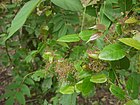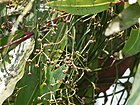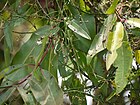Note: This is a project under development. The articles on this wiki are just being initiated and broadly incomplete. You can Help creating new pages.
Difference between revisions of "Tylophora fasciculata"
(→Parts Used) |
|||
| (One intermediate revision by the same user not shown) | |||
| Line 5: | Line 5: | ||
==Parts Used== | ==Parts Used== | ||
| − | {{Parts Used|}}, {{Parts Used| | + | {{Parts Used|Leaves}}, {{Parts Used|Roots}}. |
==Chemical Composition== | ==Chemical Composition== | ||
| Line 67: | Line 67: | ||
==References== | ==References== | ||
<references> | <references> | ||
| − | <ref name="chemical composition">[ | + | <ref name="chemical composition">[Chemical constituents]</ref> |
<ref name="Leaf">[Morphology]</ref> | <ref name="Leaf">[Morphology]</ref> | ||
<ref name="Plant name">Karnataka Aushadhiya Sasyagalu By Dr.Maagadi R Gurudeva, Page no:29</ref> | <ref name="Plant name">Karnataka Aushadhiya Sasyagalu By Dr.Maagadi R Gurudeva, Page no:29</ref> | ||
Latest revision as of 12:00, 28 August 2020
Tylophora fasciculata is a small, slender, much-branched undershrub or twining pubescent herb producing stems 30 - 90cm tall. The rhizome is 25 - 50mm in diameter. The plant is sometimes gathered from the wild for local use as a medicine and rat poison. It belongs to the Asclepiadaceae family.[1]
Contents
- 1 Uses
- 2 Parts Used
- 3 Chemical Composition
- 4 Common names
- 5 Properties
- 6 Habit
- 7 Identification
- 8 List of Ayurvedic medicine in which the herb is used
- 9 Where to get the saplings
- 10 Mode of Propagation
- 11 How to plant/cultivate
- 12 Commonly seen growing in areas
- 13 Photo Gallery
- 14 References
- 15 External Links
Uses
Parts Used
Chemical Composition
Tylophora indica contains 0.2%–0.3% alkaloids but the alkaloid content (w/w) in commercial samples is standardized to about 0.1% of tylophorine in the sun-dried material.[3]
Common names
| Language | Common name |
|---|---|
| Kannada | Adumuttada balli |
| Hindi | Anantamul |
| Malayalam | |
| Tamil | Pyapaalai |
| Telugu | Kaakapaala |
| Marathi | |
| Gujarathi | |
| Punjabi | |
| Kashmiri | |
| Sanskrit | Anantamula |
| English | Countryipikakyun |
.[1]
Properties
Reference: Dravya - Substance, Rasa - Taste, Guna - Qualities, Veerya - Potency, Vipaka - Post-digesion effect, Karma - Pharmacological activity, Prabhava - Therepeutics.
Dravya
Rasa
Guna
Veerya
Vipaka
Karma
Prabhava
Habit
Identification
Leaf
| Kind | Shape | Feature |
|---|---|---|
Flower
| Type | Size | Color and composition | Stamen | More information |
|---|---|---|---|---|
| {{{5}}} |
Fruit
| Type | Size | Mass | Appearance | Seeds | More information |
|---|---|---|---|---|---|
Other features
List of Ayurvedic medicine in which the herb is used
Where to get the saplings
Mode of Propagation
How to plant/cultivate
Annual rainfall of about 1000–1500 mm is ideal for Tylophora plant. It prefers partial shade conditions of the forests and soil rich in humus.[5]
Commonly seen growing in areas
Photo Gallery
References
External Links
- Ayurvedic Herbs known to be helpful to treat Fever
- Ayurvedic Herbs known to be helpful to treat Ulcers
- Ayurvedic Herbs known to be helpful to treat Wounds
- Herbs with Leaves used in medicine
- Herbs with Roots used in medicine
- Herbs with common name in Kannada
- Herbs with common name in Hindi
- Herbs with common name in Tamil
- Herbs with common name in Telugu
- Herbs with common name in Sanskrit
- Herbs with common name in English
- Habit - Climber
- Index of Plants which can be propagated by Seeds
- Herbs that are commonly seen in the region of Thickets
- Herbs that are commonly seen in the region of Hills among grass
- Herbs





